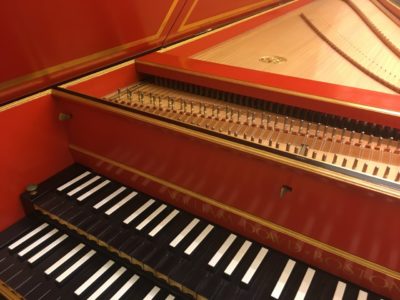Just before 7:30 p.m. on Saturday, Feb. 16, the audience section of Sebring-Lewis Hall filled with a murmur of anticipation of the musicians arriving through the stage doors to perform a program of baroque music.
The most immediately noticeable feature of the stage was an elegant black harpsichord with gold trim. Also on stage were two music stands, one at standing height and one, less extended, facing a chair upon which was leaning a viola da gamba (a 15th-century instrument that resembles a cello with broader sides and no endpin). The auditorium’s cherry-wood back wall and mint-green walls created an oddly timeless feeling, as if it were unclear whether the audience was in the present, the Baroque era or far in the future.
Performing that night was a trio of musicians accomplished in Baroque, Renaissance, and operatic styles. Mezzo-soprano Suzanne Lommler, a vocal professor at Grinnell and Simpson Colleges, has performed in lead roles at Haymarket Opera in Chicago and Opera Kelowna in British Columbia. Jory Vinikour, harpsichordist, is an internationally recognized two-time Grammy nominee. Craig Trompeter, cellist and violist da gamba, is the artistic director of the Haymarket Opera Company, and has performed with the Chicago Symphony, Lyric Opera of Chicago and the Smithonian Chamber Music Society.
Professor Jennifer Brown, music, was responsible for bringing these performers to Grinnell. She said that it has been a longtime dream of hers to bring the three musicians together to perform at the College: “[Lommler] had worked with [Vinikour and Trompeter] for many years, and they were great friends, but I also had known each of them independently, and I thought, well, wouldn’t it be great to have a concert that featured all three of them?”
The trio began the evening with two pieces by the English Baroque composer Henry Purcell, “Sweeter than Roses” (1696) and “An Evening Hymn on a Ground” (1688), followed by a performance of Girolamo Frescobaldi’s all-instrumental Canzona in A (1628). Then came Barbara Strozzi’s 1651 “L’Eraclito amoroso,” after which Lommler stepped out for the next two instrumental pieces: Martin Marais’ “Le Labyrinthe” (1717) and Bernardo Storace’s “Ciaconna” (1664). Vinikour provided a brief introduction to the Storace piece, explaining that almost nothing is known about the composter; all but one book of his work being lost in earthquakes in Italy during the 18th and 20th centuries.
On bringing baroque music to Grinnell, Brown said, “I think it’s important to bring any kind of music that is done by top-notch professionals in their field, but particularly for me, as I teach this material here, it is very directly related to what I’m doing in the classroom, in my music history courses, and in Collegium [the Collegium Musicum, an early music performance ensemble] and especially in my baroque improvisation seminar — they were able to assist directly with that with a workshop they gave.”
To finish out the first act, Lommler returned to the stage to perform Benedetto Ferrari’s 1641 piece “Amanti, io vi só dire.” Throughout the act, each musician’s skill shone through: Vinikour’s ability was especially highlighted by the complex “Ciaconna,” while the mellow smoothness of Trompeter’s viola da gamba demonstrated his artistry at “shaping” the line of the music and Lommler’s rich vibrato revealed the emotional side of the music.
Trompeter’s viola da gamba demonstrated his artistry at “shaping” the line of the music and Lommler’s rich vibrato revealed the emotional side of the music.
After intermission, Trompeter switched from the viola da gamba to the baroque cello. Vinikour played George Friedrich Handel’s six-movement Suite in G Minor (1720). Lommler and Trompeter then joined Vinikour for a performance of the tragic cantata La Lucrezia (1709), also by Handel. Lommler’s voice and expressions took center stage to make it an enthralling finale. After a standing ovation, all three returned to the stage for a performance of “Habanera” from the 1875 Georges Bizet opera “Carmen.”
This article has been editing to reflect that only Jory Vinikour was the sole musician that played George Friedrich Handel’s six-movement Suite in G Minor (1720).





























































